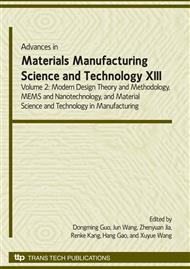p.679
p.685
p.691
p.697
p.703
p.709
p.715
p.721
p.727
Investigations of the High Vacuum Die Castings of Dumbbell Specimens
Abstract:
Compare to atmosphere die casting or moderate vacuum die casting process, use of the high vacuum die casting can enhance excluding gas volumes in the mold, improve the casting mechanical properties and density, and increase the fabrication feasibility for casting small feature size, shape, and higher quality of product. The process of high vacuum die casting for dumbbell specimens is established and implemented for evaluation of this innovative manufacturing technology. A transparent acrylic mold is fabricated to investigate the vacuum injection for vacuum die casting process and a metal mold is fabricated to test the real manufacturing of high vacuum die casting. To visualize the flowing pattern inside the mold under the consequence of evacuation processing, flow visualization experiments are conducted. Then, the specimen is molded by the high vacuum die casting process and the specimen castings are test by a universal testing machine for its loading-elongation relationship. The porosities of specimen casting are examined by scale weighting and direct visual inspection ways. Experimental results show that the high vacuum die casting process is effective to reduce the porosity (5.47% increment in weight) and to increase the strength (4.83% increment in maximum stress) of the investigated specimen. An obviously vortex roll is established along the centerline position of dumbbell specimen which may be became the source of porosity in real processing. Meanwhile, an excellent vacuum sealing is critical to the success of high vacuum die casting.
Info:
Periodical:
Pages:
727-734
Citation:
Online since:
August 2009
Authors:
Keywords:
Price:
Сopyright:
© 2009 Trans Tech Publications Ltd. All Rights Reserved
Share:
Citation:


